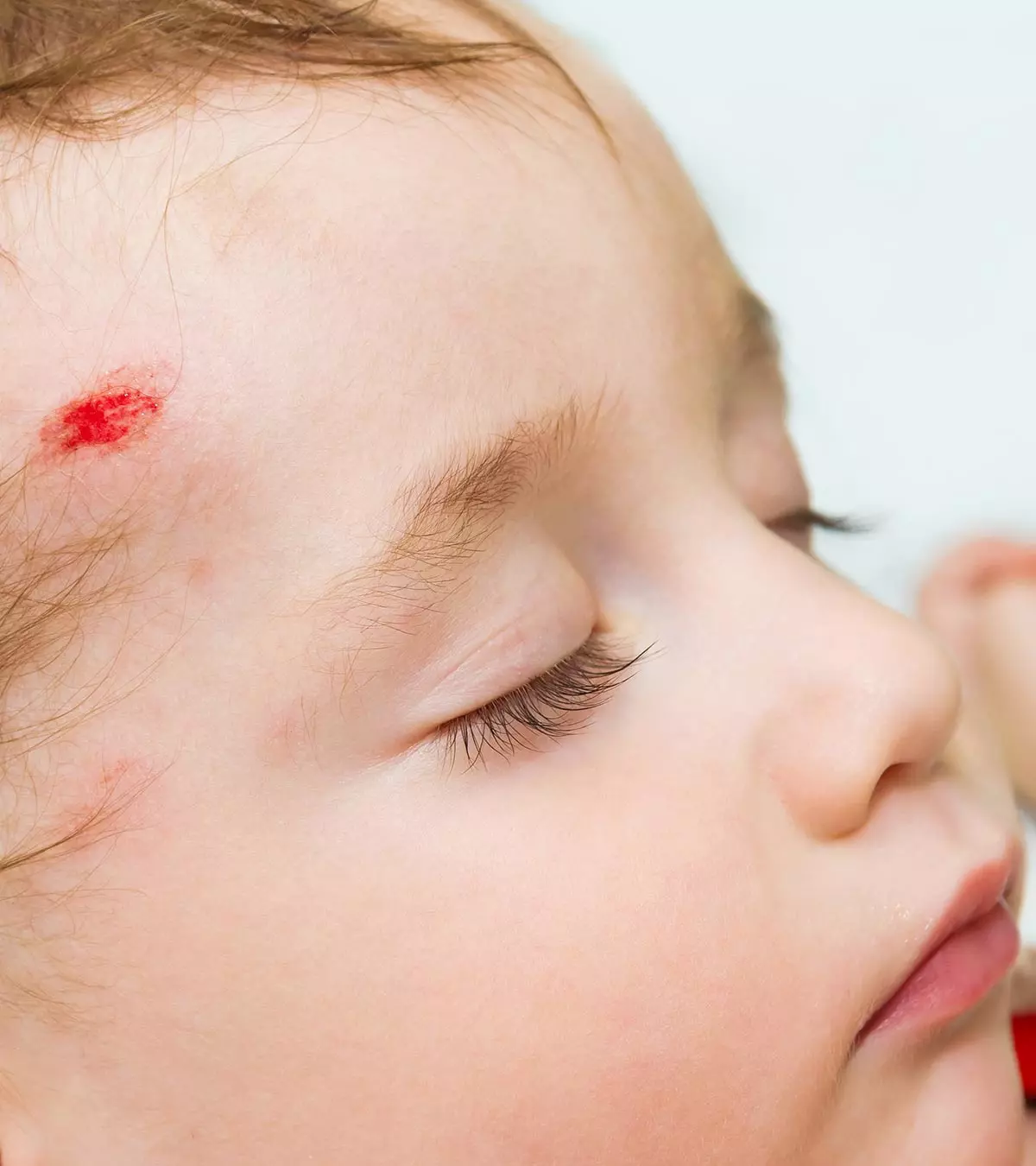
Image: Shutterstock
Autism or autism spectrum disorders (ASDs) are developmental disorders that include various conditions affecting social interactions and behavioral skills in a child (1) (2). Autism in a 3-year-old could significantly impact the development of these skills. As per the World Health Organization reports, one in 160 children in the world has ASD (3). At the same time, based on the CDC’s Autism and Developmental Disabilities Monitoring (ADDM) Network, the estimated prevalence of autism spectrum disorder (ASD) in the US is approximately 1 in 36 children (14).

There is no single, well-known cause of autism, and it might occur due to various environmental and genetic factors. However, you may notice signs of this condition in your child by the age of two or three years. Although there is no known cure for autism, the condition can be effectively managed with techniques designed to enhance the quality of the child’s life.
Explore more about the symptoms, diagnosis, and management options for autism in a three-year-old.
Key Pointers
- Lack of social and communication skills and behavioral issues are common in children with autism.
- Try therapies and intervention techniques and help your little one perform daily activities smoothly.
- Understand the severity level to deal with the situation in a better and proper way.
Signs And Symptoms Of Autism In A Three-Year-Old

According to the American Academy of Pediatrics (AAP), babies could display early signs of autism before their first birthday (4). The more typical signs emerge before the age of two years or by three years. The signs and symptoms of autism usually present in three domains — social skills, communication skills, and behavior.
Lack of social skills is a common sign of an autistic child at age 3. You may notice the following shortcomings in social skills (5).
- Doesn’t respond to name
- Avoids eye contact
- Does not share with others
- Plays alone
- Doesn’t take turns during activities
- No interest in socializing or inclusion with others
- Avoids physical contact with others
- Inappropriate facial expressions or no expression at all
- Not able to express feelings
- Not empathetic
- Difficult to soothe or comfort
Language and communication skills could be below the expected levels
in three-year-olds with autism. You may notice the following issues (5).
- Delayed language development
- Repeating words or phrases (Echolalia)
- Inappropriate answers to questions
- Repeats what others say
- Does not point at objects of interest
- Does not respond to others pointing to an object
- No gestures or body movements, such as waving hands to say goodbye
- Talks in a flat voice
- Does not pretend play
- Lack of understanding of jokes or do not respond when teased
- Reverses pronouns, such as saying “I” instead of “You”
Behavioral issues are common in three-year-olds with autism. You may notice the following behavioral attributes (5).
- Line up toys or place objects in an organized way

- Becomes upset, frustrated or have meltdowns if there is a small change in the structure of their daily routine
- Stimming, i.e., making repetitive motions, such as spinning, flapping hands, or rocking back and forth
- Play with a specific part of an object or a toy, such as spinning the wheels of a toy car repeatedly
- May have odd routines, such as always wanting to shut the doors
- Shows obsessive interests
- Short attention span or a complete attention deficit
- Hyperactivity
- Aggression and anxiety
- Self-harming, such as self-scratching or punching
- Severe tantrums and depression
- Lack of fear in situations where it is natural and expected
- Irregular eating patterns and sleeping habits
 Experts say
Experts sayJames Guttman, a father of two, one of whom is non-verbal with autism, shares his observations of early symptoms in his son (with autism). He says, “I remember wincing as he would spin a toy on the ground and begin waving his hand above it. To relatives, friends, and outsiders, though, he was fine.”
He also emphasizes that his son’s participation in music classes was limited, “When the class would start, he would do very little in terms of participation. Kids half his size crawled over to strum the guitar while looking at their parents with a smile. My son would dart for the door or lay down on the floor with his hands cradling his head as if he was about to fall asleep (i).”
 Quick fact
Quick factSome of these symptoms may even occur in three-year-olds who do not have ASD. However, consult a pediatrician if your child shows any of these symptoms. Many of these signs and symptoms may also occur in other conditions, such as a developmental delay in children. Speech delay and lack of eye contact may need more prompt care to determine the presence of hearing or vision problems.
Difference Between Autism Symptoms In Girls And Boys
Autism symptoms can be similar in both boys and girls. However, autism is often easily identified in boys due to their behavioral and playing habits. Girls may try to mimic the language and social skills of their surroundings. Thus, it may go unnoticed in girls for more time.
Boys can be more interested in spinning parts or wheels of a toy than girls. In comparison, girls tend to arrange objects, such as toys, in a specific way. Nevertheless, both boys and girls with autism show an obsession for keeping objects in a preferred way and may throw tantrums when the order is changed (6).
 Did you know?
Did you know?Difference Between Mild And Severe Symptoms Of Autism

The severity of autism disorder may vary in each child from mild to severe. It means some children with ASD have advanced learning skills, whereas others may require assistance for daily activities.
Depending on the severity and the support required, the Diagnostic and Statistical Manual of Mental Disorders (DSM-5) defines three levels of autism (7).
| Severity | Symptoms and signs |
|---|---|
| Level 1: Requiring support |
|
| Level 2: Requiring substantial support |
|
| Level 3: Requiring very substantial support |
|
Autism or autism spectrum disorder (ASD) are treated based on the level of severity. Children with mild ASD (level 1) may have better treatment outcomes than severe (level 3) cases.
Autism Diagnosis In Three-Year-Olds
There is no specific imaging or laboratory test to diagnose autism. Observation of behaviors and developmental skills can indicate the presence of ASD in three-year-old children. Experts at the American Academy of Pediatrics (AAP) state that children are often diagnosed with autism spectrum disorders by the age of two. They further specify that the three key areas to examine for autism signs in toddlers are social interactions, communication, and repetitive behaviors (4). Medical tests to exclude hearing and vision problems are performed before confirming the diagnosis (8).
Doctors may play and interact with the toddlers to assess them and see if they have sensory processing issues, such as difficulty with sensory integration, which often causes sensory overload. Parents may also be asked to fill questionnaires regarding their child’s behaviors and skills. After the initial evaluation, a pediatrician may refer suspected cases to specialists for detailed examination.
 Research finds
Research findsEmphasizing the importance of early diagnosis and timely therapy for autism, blogger Annie Newmans recounts, “While I want to stress it is never too late to start helping your child with autism, getting them diagnosed earlier gets them access to critical early intervention services BEFORE school that can help make the elementary years and beyond so much smoother. We were lucky in the fact that I had a pediatrician who was willing to refer Emmy (daughter) to a developmental pediatrician before I even asked. We were also very lucky to live in a state with mandated early intervention: this meant all I needed was a ‘prescription’ for it from my regular pediatrician, and Emmy was able to start speech and OT months before even being evaluated for autism (ii).”
Management Of Autism
There is no cure for autism spectrum disorder. Thankfully, there are several therapies and intervention techniques to manage autism. These management techniques can reduce symptoms and enhance the child’s abilities, thus making them perform daily activities with minimal difficulty.
Here are some therapies that can help manage autism spectrum disorder in children (9).
- Applied behavior analysis (ABA) is the method to teach speech, life skills, and language to the autistic child.
- Behavioral management therapy helps reduce unwanted behaviors and reinforce good behaviors.

- Cognitive behavior therapy (CBT) helps modify the thoughts to change the child’s mood or behavior.
- School-based therapies are important for autistic children to learn about social interactions and activities.
- Nutrition therapy is recommended for autistic children with digestive issues and nutritional deficiencies.
- Joint attention therapy teaches the use of nonverbal communications, such as gaze and gestures to communicate.
- Parent-mediated therapy involves interventions that parents can teach the child. Parents are trained by experts, and they should continue to train the child at home as recommended.
- Social skills training aims to develop social skills in a structured manner.

- Occupational therapy (OT) helps children learn the skills required for performing daily activities.
- Speech and language therapy helps deal with communication difficulties and expression.
 Quick fact
Quick factTherapies are chosen based on each child’s specific requirement since disorders, such as ADHD, may overlap with ASD in some children. Early interventions during preschool or before are shown to have positive effects. Depending on the severity of ASD, doctors may suggest special education centers with visual aids and assistive technology for children with autism.
Dr. Geraldine Dawson, Professor of Psychiatry and Behavioral Sciences at Duke University, speaks about the importance of parental roles in ensuring a treatment plan’s benefit and effectiveness. She suggests that parents incorporate play and behavior therapies based on their child’s interests to help them adapt seamlessly and derive its benefits (16).
Frequently Asked Questions
1. What is high-functioning autism in 3-year-olds?
High-functioning autism is when your toddler might have problems with acquiring social skills needed for interacting with other children or/and has cognitive impairment, language development delays, and learning difficulties (10).
2. Do children with autism laugh?
Yes, children with autism laugh as other children do. However, research notes that they usually laugh as a response to a positive internal state rather than in social interactions. There is no difference in the duration of laughter from other children (11).
3. Do toddlers with autism have trouble eating?
Yes, toddlers with autism may avoid a specific category of foods such as vegetables or proteins. They may also exhibit serious behavioral issues when offered food that they dislike (12).
4. Where can I find support and resources for my child with autism?
You may reach out to your family and loved ones or join online forums and local support groups, where parents facing similar challenges could provide you with valuable tips. Organizations like Autism Speaks and the CDC also offer helpful information and community resources.
5. Can diet affect autism symptoms?
Some parents use exclusion diets, such as gluten-free and casein-free diets, to help improve autism symptoms. However, scientific evidence supporting their effectiveness is limited; thus, medical supervision is recommended to determine what suits your child best (17).
Lack of social skills, delayed language and communication skills, and behavioral difficulties are some early signs of autism in 3-year-olds. The severity of the condition varies among different children, with some requiring assistance in everyday tasks. However, early detection and intervention can help most children with autism learn the skills they need to manage their condition without affecting other aspects of their lives. Your child’s doctor may recommend a combination of behavior and psychotherapy, nutrition therapy, parent-mediated therapy, occupational therapy, and other treatments.
Infographic: How To Help Your Three-Year-Old Child With Suspected Autism Spectrum Disorders?
A three-year-old child may not have a confirmed diagnosis of autism other than concerning signs. However, early training and parenting strategies to handle their special needs could improve their quality of life. Check out the infographic to learn strategies to help a three-year-old with suspected autism.
Some thing wrong with infographic shortcode. please verify shortcode syntax
Some thing wrong with illustration image shortcode. please verify shortcode syntax
Acquaint yourself with the initial indicators of autism through this enlightening video. Gain expertise in identifying these cues and understanding the steps toward assistance.
Personal Experience: Sources
MomJunction articles include first-hand experiences to provide you with better insights through real-life narratives. Here are the sources of personal accounts referenced in this article.
i. When you’re first to spot autism’s early signs;https://hiblogimdad.com/2025/04/13/the-first-to-spot-autisms-early-signs/
ii. Is My Child Autistic? Surprising Early Signs;
https://anniedrawsandmore.medium.com/is-my-child-autistic-surprising-early-signs-3205617bd57a
References
1. What Is Autism? Autism Speaks
2. About Autism Spectrum Disorder; CDC
3. Autism spectrum disorders; WHO
4. What are the Early Signs of Autism?; American Academy of Pediatrics
5. Signs and Symptoms of Autism Spectrum Disorder; CDC
6. Signs of Autism In Different Age Groups and Genders; Otsimo
7. Rami Grossmann, What is ASD (Autism Spectrum Disorder)?; ChildBrain
8. Autism Spectrum Disorder in Children; University of Rochester
9. Autism Spectrum Disorder Basics; Child Mind Institute
10. Advice for Parents; Evidence-based Treatment During Early Intervention; Autism Research Institute.
11. William J. Hudenko; Laughter Differs in Children with Autism: An Acoustic Analysis of Laughs Produced by Children With and Without the Disorder; Journal of Autism and Developmental Disorders.
12. Eating habits—when to worry; Marcus Autism Center
13. Treatment and Intervention for Autism Spectrum Disorder; CDC
13. Data and Statistics on Autism Spectrum Disorder; CDC
14. Early Warning Signs of Autism Spectrum Disorder; CDC
15. Elizabeth Harstad et al., (2025); Persistence of Autism Spectrum Disorder From Early Childhood Through School Age; JAMA Network
16. Speaking of Psychology: How early detection could change autism diagnosis and intervention, with Geraldine Dawson, PhD; American Psychological Association
17. Claire Millward et al., (2014); Gluten- and casein-free diets for autistic spectrum disorder; Cochrane Database of Systematic Reviews
Community Experiences
Join the conversation and become a part of our nurturing community! Share your stories, experiences, and insights to connect with fellow parents.
Read full bio of Dr. Maymunah Yusuf Kadiri
Read full bio of Dr Bisny T. Joseph
Read full bio of Rohit Garoo
Read full bio of Apoorva K


















